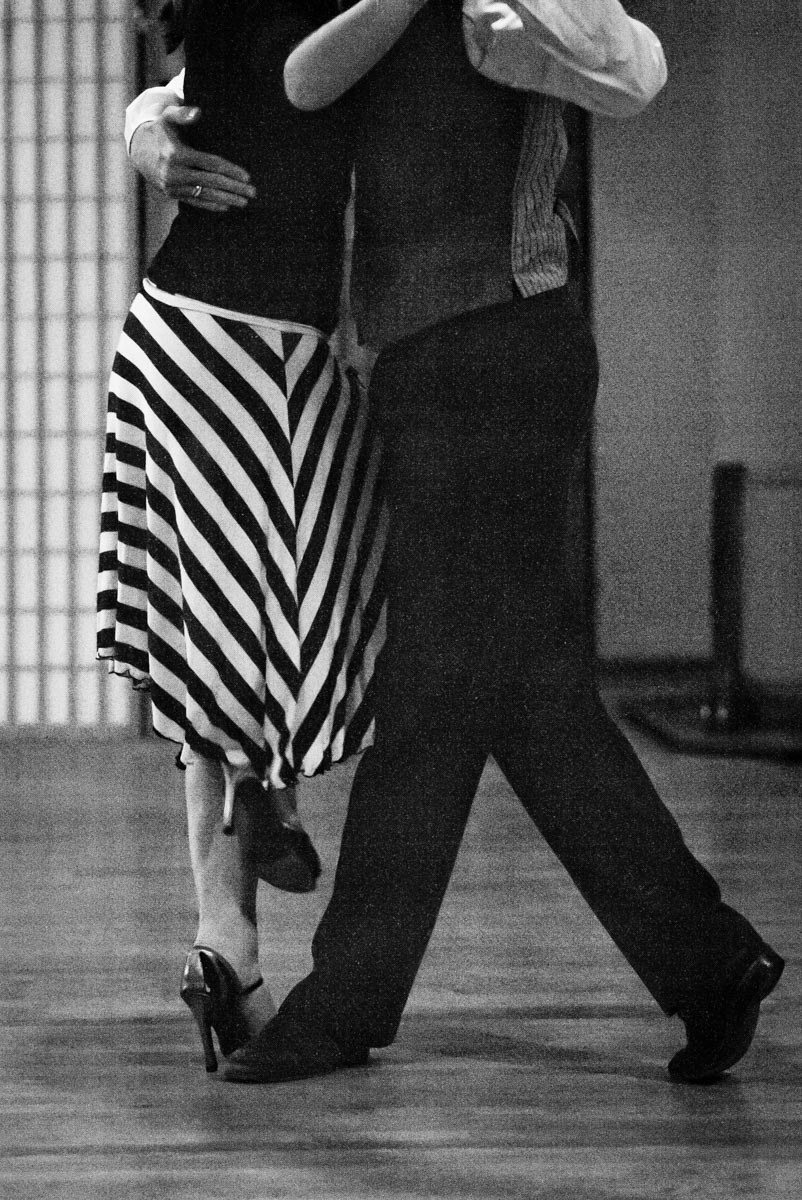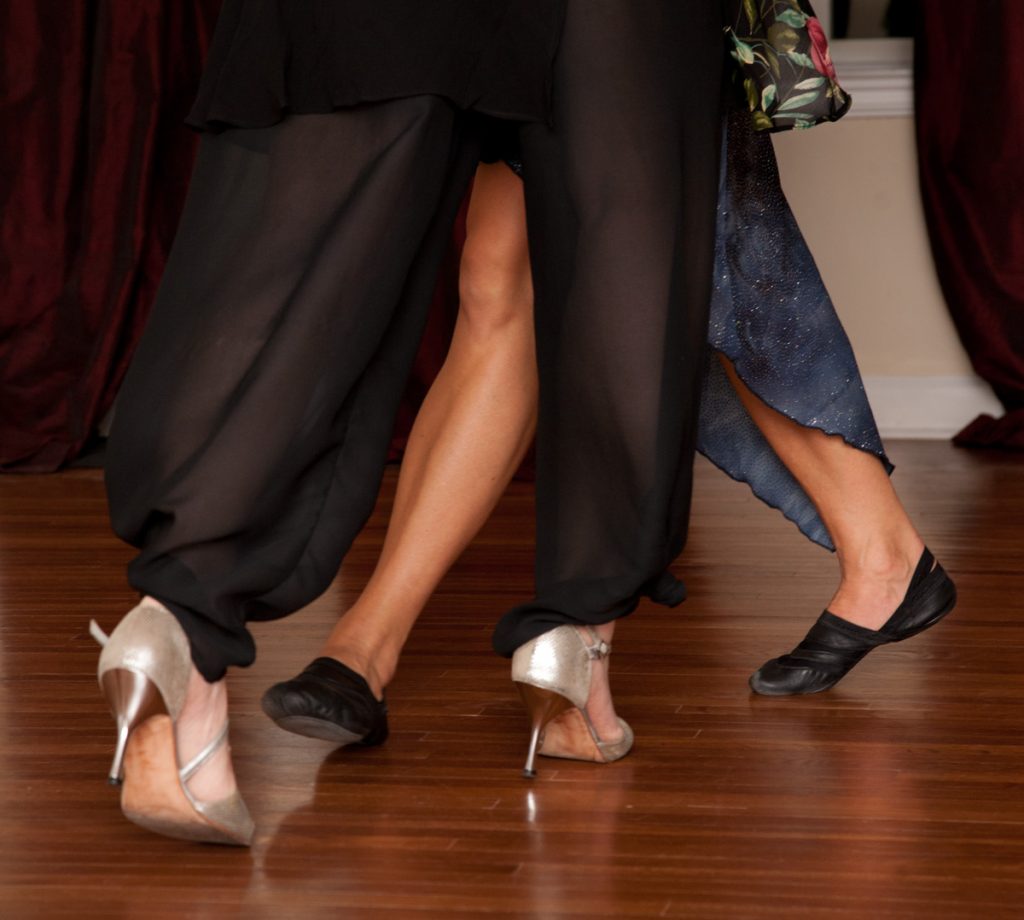TangoMind
A Learning and Social Community for People with Parkinson's
COVID-19: During this period of physical distancing we will not be holding any in-person classes. But, there are still ways to connect to the dance! Read on to learn more and sign up to receive updates about the program. Any reference to joining classes are for the time when we will dance again!
Dance & Parkinson's
Parkinson’s disease (PD) is a progressive neurodegenerative disorder which causes the death of dopaminergic neurons in a part of the midbrain known as the substantia nigra pars compacta. The loss of these neurons in the pars compacta lead to greatly reduced dopamine levels and, consequently, reduced control of voluntary movement and a broad array of behavioral processes such as mood, reward, addiction, and stress.1Chinta SJ, Andersen JK. Dopaminergic neurons. Int J Biochem Cell Biol. 2005 May;37(5):942-6. https://doi.org/10.1016/j.biocel.2004.09.009 Epub 2004 Dec 2. PMID: 15743669. A systematic review and meta-analysis in 2020 of a great deal of research, summarized below, concerning Dance, and often specifically Tango, for people with Parkinson’s Disease (PD) by Anna M. Carapellotti, et. al., “The efficacy of dance for improving motor impairments, non-motor symptoms, and quality of life in Parkinson’s disease”, makes a good case for how dance may be a good choice to help with wide ranging issues facing people living with PD.
The disorder is characterized by both motor and non-motor symptoms that impact quality of life (QOL) 2Berganzo K, Tijerom B, Gonza ́ lez-Eizaguirre A, Somme J, Lezcano E, Gabilondo I, et al. Motor and non-motor symptoms of Parkinson’s disease and their impact on quality of life and on different clinical subgroups. Neurolog ́ıa (English Edition). 2016; 36. https://doi.org/10.1016/j.nrleng.2014.10.016 . The cardinal motor symptoms of PD include bradykinesia, tremor, rigidity, and postural instability 3Moustafa AA, Chakravarthy S, Phillips JR, Gupta A, Keri S, Polner B, et al. Motor symptoms in Parkinson’s disease: A unified framework. Neuroscience & Biobehavioral Reviews. 2016; 68. https://doi.org/10.1016/j.neubiorev.2016.07.010 PMID: 27422450. Nonmotor symptoms, such as mental health issues (e.g., depression), cognitive impairment, pain, and fatigue, are also prevalent among people living with PD, and these issues may have a greater impact on QOL than motor impairments 4Pfeiffer RF. Non-motor symptoms in Parkinson’s disease. Parkinsonism & Related Disorders. 2016; 22. https://doi.org/10.1016/j.parkreldis.2015.09.004 PMID: 26372623. As PD progresses, activities of daily living (ADL) become increasingly challenging 5Shulman LM, Gruber-Baldini AL, Anderson KE, Vaughan CG, Reich SG, Fishman PS, et al. The evolution of disability in Parkinson disease. Movement Disorders. 2008; 23(6). https://doi.org/10.1002/mds.21879 PMID: 18361474, and this can lead to physical inactivity, social isolation, and increased dependence on family members and carers 6Tomlinson CL, Herd CP, Clarke CE, Meek C, Patel S, Stowe R, et al. Physiotherapy for Parkinson’s disease: A comparison of techniques. Cochrane Database of Systematic Reviews. 2014; 6. https://doi.org/10.1002/14651858.CD002815.pub2 PMID: 24936965. While current pharmacological and neurosurgical treatments can help to alleviate symptoms, these methods do not fully address complications such as balance problems 7McKay JL, Ting LH, Hackney ME. Balance, Body Motion, and Muscle Activity After High-Volume Short- Term Dance-Based Rehabilitation in Persons With Parkinson Disease: A Pilot Study. Journal of neurologic physical therapy. 2016; 40. https://doi.org/10.1097/NPT.0000000000000112 PMID: 26630325 and non-motor symptoms 8Titova N, Chaudhuri KR. (2017). Personalized medicine and non-motor symptoms in Parkinson’s disease, International Review of Neurobiology, 134, 1257–1281. https://doi.org/10.1016/bs.irn.2017.05.015 PMID: 28805572, leading to a need for high-quality complimentary treatment strategies that improve QOL.
Dance, a creative activity that poses both physical and cognitive demands, has been shown to address motor impairments in people living with PD in a number of small studies. 9Shanahan J, Morris ME, Bhriain ON, Sanders J, Clifford AM. Dance for people with Parkinson’s disease: What is the evidence telling us? Archives of Physical Medicine and Rehabilitation. 2015; 96(1). https://doi.org/10.1016/j.apmr.2014.08.017 PMID: 25223491 There is evidence that long-term dance practice can modify motor symptom progression 10Duncan RP, Earhart GM. Randomized controlled trial of community-based dancing to modify disease progression in Parkinson’s disease, Neurorehabilitation and Neural Repair. 2012; 26. https://doi.org/10.1177/1545968311421614 PMID: 21959675 and that it can improve balance more effectively than other forms of physical activity 11Hackney ME, Kantorovich S, Levin R, Earhart GM. Effects of tango on functional mobility in Parkinson’s disease: A preliminary study. Journal of Neurologic Physical Therapy. 2007a; 31. https://doi.org/10.1097/NPT.0b013e31815ce78b PMID: 18172414 12Rios Romenets SR, Anang J, Fereshtehnejad SM, Pelletier A, Postuma R. Tango for treatment of motor and non-motor manifestations in Parkinson’s disease: A randomized controlled study, Complementary Therapies in Medicine. 2015; 23. doi.org/10.1016/j.ctim.2015.01.015 PMID: 25847555. Dance has also been demonstrated to show beneficial effects on gait variables in PD, such as velocity and stride length 13Hackney ME, Earhart GM. Effects of dance on movement control in Parkinson’s disease: A comparison of Argentine Tango and American Ballroom, Journal of Rehabilitative Medicine. 2009a; 41. https://doi.org/10.2340/16501977-0362 PMID: 19479161 14Hackney ME, Earhart GM. Effects of dance on gait and balance in Parkinson’s disease: A comparison of partnered and non-partnered dance movement, Neurorehabilitation and Neural Repair. 2010a; 24. https://doi.org/10.1177/1545968309353329 PMID: 20008820. More recently, researchers have begun investigating dance’s potential effects on non-motor PD symptoms, such as cognitive impairment and depression 15Zhang Q, Hu J, Wei L, Jia Y, Jin Y. Effects of dance therapy on cognitive and mood symptoms in people with Parkinson’s disease: A systematic review and meta-analysis. Complementary Therapies in Clinical Practice. 2019; 36. https://doi.org/10.1016/j.ctcp.2019.04.005 PMID: 31383428. Depending on the dance style or technique being practiced, dance classes may train a variety of cognitive skills. For example, dance may improve attention and memory, which are important for learning new dance steps and choreographic sequences. Results thus far have demonstrated that dance can positively impact spatial cognition 16McKee KE, Hackney ME. The effects of adapted tango on spatial cognition and disease severity in Parkinson’s disease. Journal of motor behavior. 2013; 45. https://doi.org/10.1080/00222895.2013.834288 PMID: 24116748, cognitive switching 17Ventura MI, Barnes DE, Ross JM, Lanni KE, Sigvardt KA, Disbrow EA. A pilot study to evaluate multi- dimensional effects of dance for people with Parkinson’s disease, Contemporary Clinical Trials. 2016; 63. https://doi.org/10.1016/j.cct.2016.10.001 PMID: 27765693, and mental rotation abilities 18Hashimoto H, Takabatake S, Miyaguchi H, Nakanishi H, Naitou Y. Effects of dance on motor functions, cognitive functions, and mental symptoms of Parkinson’s disease: A quasi-randomized pilot trial. Complementary Therapies in Medicine. 2015; 23. https://doi.org/10.1016/j.ctim.2015.01.010 PMID: 25847558. In addition to engaging cognitive processes, dance is typically practiced in a social, enjoyable environment, which may reduce isolation and impart psychological benefits 19Lewis C, Annett LE, Davenport S, Hall AA, Lovatt P. Mood changes following social dance sessions in people with Parkinson’s disease. Journal of Health Psychology. 2016; 21. https://doi.org/10.1177/1359105314529681 PMID: 24752558.
Through the amelioration of motor and non-motor symptoms, QOL may improve in people living with PD. Health-related QOL is defined as the impact an illness and its consequences have on a person as determined by their own perceptions and evaluations 20Hackney ME, Earhart GM. Health related quality of life and alternative forms of exercise in Parkinson’s disease, Parkinsonism and Related Disorders. 2009b; 15. https://doi.org/10.1016/j.parkreldis.2009.03.003 PMID: 19329350. There are a number of mechanisms through which dance may improve QOL including but not limited to improved motor function 21Hackney ME, Earhart GM. Health related quality of life and alternative forms of exercise in Parkinson’s disease, Parkinsonism and Related Disorders. 2009b; 15. https://doi.org/10.1016/j.parkreldis.2009.03.003 PMID: 19329350, engagement with music 22Hackney ME, Bennett C. Dance therapy for individuals with Parkinson’s disease: improving quality of life. Research and Reviews in Parkinsonism. 2014; 4. https://doi.org/10.2147/JPRLS.S40042 , and socialization 23Bognar S, DeFaria AM, O’Dwyer C, Pankiw E, Bogler JS, Teixeira S, et al. More than just dancing: experiences of people with Parkinson’s disease in a therapeutic dance program. Disability and Rehabilitation. 2017; 39. https://doi.org/10.3109/17483107.2015.1063018 PMID: 26123759 24Holmes WM, Hackney ME. Adapted tango for adults with Parkinson’s disease: A qualitative study, Adapted Physical Activity Quarterly. 2017; 34. https://doi.org/10.1123/apaq.2015-0113 PMID: 28727513.
Overall, the evidence suggests that dance can have a positive impact in those living with mild to moderate PD, with the results most strongly supporting its ability to manage motor symptom severity in comparison to usual care and to improve balance and functional mobility more effectively than usual care or another form of physical activity…and non-motor symptom (i.e., improve symptoms of depression measured using the BDI-II), with the results favoring dance. 25Carapellotti, A. M., Stevenson, R. and Doumas, M. (2020) ‘The efficacy of dance for improving motor impairments, non-motor symptoms, and quality of life in Parkinson’s disease: A systematic review and meta-analysis’, PLoS ONE, 15(8). doi: 10.1371/journal.pone.0236820.
Many studies show that dance can improve motor symptom severity more effectively than usual care 26Duncan RP, Earhart GM. Randomized controlled trial of community-based dancing to modify disease progression in Parkinson’s disease, Neurorehabilitation and Neural Repair. 2012; 26. https://doi.org/10.1177/1545968311421614 PMID: 21959675 27Hackney ME, Earhart GM. Effects of dance on movement control in Parkinson’s disease: A comparison of Argentine Tango and American Ballroom, Journal of Rehabilitative Medicine. 2009a; 41. https://doi.org/10.2340/16501977-0362 PMID: 19479161 28Lee H, Kim S, Chae Y, Kim M, Yin CY, Jung W, et al. Turo (Qi dance) program for Parkinson’s disease patients: Randomized, assessor blind, waiting-list control, partial crossover study. Explore. 2018; 14. https://doi.org/10.1016/j.explore.2017.11.002 PMID: 29650371 29Solla P, Cugusi L, Bertoli M, Cereatti A, Della Croce U, Pani D, et al. Sardinian folk dance for individuals with Parkinson’s disease: A randomized controlled pilot trial. J Altern Complement Med. 2019; 25 (3):305–316. https://doi.org/10.1089/acm.2018.0413 PMID: 30624952 . Given the progressive nature of PD, it is of great clinical importance that dance has the potential to modify disease progression, which could have implications for outcomes related to disability and QOL. A study by Duncan and Earhart 30Duncan RP, Earhart GM. Are the effects of community-based dance on Parkinson disease severity, balance and functional mobility reduced with time? A 2-year prospective pilot study, The Journal of Alternative and Complementary Medicine. 2014; 20. https://doi.org/10.1089/acm.2012.0774 PMID: 25192393 showed improvement after 12 and 24 months of tango. Moreover, studies also revealed that dance, specifically tango, may be superior at improving balance and functional mobility than other forms of physical activity traditionally available to people with PD 31Hackney ME, Kantorovich S, Levin R, Earhart GM. Effects of tango on functional mobility in Parkinson’s disease: A preliminary study. Journal of Neurologic Physical Therapy. 2007a; 31. https://doi.org/10.1097/NPT.0b013e31815ce78b PMID: 18172414 32Rios Romenets SR, Anang J, Fereshtehnejad SM, Pelletier A, Postuma R. Tango for treatment of motor and non-motor manifestations in Parkinson’s disease: A randomized controlled study, Complementary Therapies in Medicine. 2015; 23. doi.org/10.1016/j.ctim.2015.01.015 PMID: 25847555 Among studies that compared two types of dance, Rocha et al. 33Rocha P, Aguiar L, McClelland JA, Morris ME. Dance therapy for Parkinson’s disease: A randomized feasibility trial, International Journal of Therapy and Rehabilitation. 2018; 25. https://doi.org/10.12968/ijtr.2018.25.2.64 found tango to improve balance and functional mobility to a greater degree than a mixed-dance program, and Kunkel et al. 34Kunkel D, Fitton C, Roberts L, Pickering RM, Roberts HC, Wiles R, et al. A randomized controlled feasi- bility trial exploring partnered ballroom dancing for people with Parkinson’s disease. Clinical Rehabilita- tion. 2017; 31. https://doi.org/10.1177/0269215517694930 PMID: 28933613 suggest that teaching several types of ballroom/Latin American dance may have led to null results of motor outcomes by diluting any physical effects. {It is better to learn to speak fluently in one language, and feel some accomplishment with speaking well with another people than it is to try to get by in many different languages. Tango is a language in the way that one learns to dance it, improvisationally. mmd } Three studies measured the impact of dance on dual tasking while walking, with one study finding a positive impact on gait velocity after six and 12 months of tango 35Duncan RP, Earhart GM. Randomized controlled trial of community-based dancing to modify disease progression in Parkinson’s disease, Neurorehabilitation and Neural Repair. 2012; 26. https://doi.org/10.1177/1545968311421614 PMID: 21959675 and one finding improvement in the DT-TUG (Dual Task-Timed Up and Go) after three months of tango 36Rios Romenets SR, Anang J, Fereshtehnejad SM, Pelletier A, Postuma R. Tango for treatment of motor and non-motor manifestations in Parkinson’s disease: A randomized controlled study, Comple- mentary Therapies in Medicine. 2015; 23. doi.org/10.1016/j.ctim.2015.01.015 PMID: 25847555 . Despite the lack of non-motor evaluation in published RCTs, there is evidence supporting tango’s potential to impact cognitive function in people living with PD from controlled, non-randomized studies, which demonstrated that it can improve executive function 37De Natale ER, Paulus KS, Aiello E, Sanna B, Manca A, Sotgiu G, et al. Dance therapy improves motor and cognitive functions in patients with Parkinson’s disease. NeuroRehabilitation. 2017; 40. https://doi.org/10.3233/NRE-161399 PMID: 27814308 and spatial cognition 38McKee KE, Hackney ME. The effects of adapted tango on spatial cognition and disease severity in Par- kinson’s disease. Journal of motor behavior. 2013; 45. https://doi.org/10.1080/00222895.2013.834288 PMID: 24116748 .
Dance is a multidimensional, sensory experience that engages attention, memory, and many other cognitive processes. It has also been identified as the leisure activity most associated with a lower risk of dementia among community-dwelling older adults 39Verghese J, Lipton RB, Katz MJ, Hall CB, Derby CA, Kuslansky G, et al. Leisure activities and the risk of dementia in the elderly, New England Journal of Medicine. 2003; 348. https://doi.org/10.1056/NEJMoa022252 PMID: 12815136 , and a recent review showed that dance can have a positive effect on global cognition in this demographic 40Meng X, Li G, Jia Y, Liu Y, Shang B, Liu P, et al. Effects of dance intervention on global cognition, exec- utive function and memory of older adults: a meta-analysis and systematic review. Aging Clinical and Experimental Research. 2019; 32. https://doi.org/10.1007/s40520-019-01159-w PMID: 30982217 . Interventions that target cognition are important for people with PD, many of whom develop dementia 41Chen JH, Hong CT, Wu D, Chi WC, Yen CF, Liao HF. Dementia-Related Functional Disability in Moder- ate to Advanced Parkinson’s Disease: Assessment Using the World Health Organization Disability Assessment Schedule 2.0. Int J Environ Res Public Health. 2019 Jun; 16(12): 2230. https://doi.org/10.3390/ijerph16122230 PMID: 31238603 .
Mental imagery ability, the cognitive process involved in creating visual, auditory, and kinesthetic images in the mind 42Kosslyn SM, Ganis G, Thompson WL. Neural Foundations of Imagery. Nature Reviews Neuroscience. 2001; 2. https://doi.org/10.1038/35090055 PMID: 11533731 , is another promising tool in PD rehabilitation 43Abraham A, Hart A, Andrade I, Hackney ME. Dynamic Neuro-Cognitive Imagery improves mental imagery ability, disease severity, and motor and cognitive functions in people with Parkinson’s disease. Neural Plasticity. 2018. https://doi.org/10.1155/2018/6168507 PMID: 29725348 that may be improved through dance. {Body Schema is the neurological way individuals sense where they are in space, and also the way one senses, by extension, the space occupied by tools like hammers, cars, and dance partners. This is very useful and it is developed in tango, in particular when dancing in a close embrace. mmd} Dance instructors often use imagery to convey the desired movement quality during teaching and encourage visualization during movement execution.
Quality of Life (QOL)
Dance has the potential to improve QOL not only through the management of motor and non-motor symptoms but also through providing social support and a creative outlet… Hackney & Earhart 44Hackney ME, Earhart GM. Health related quality of life and alternative forms of exercise in Parkinson’s disease, Parkinsonism and Related Disorders. 2009b; 15. https://doi.org/10.1016/j.parkreldis.2009.03.003 PMID: 19329350 found 20 tango sessions to have a positive effect on the PDQ-39 SI and Mobility and Social Support sub-scores.
Engaging in an artistic intervention is a complex experience and as such its impact on QOL may not fully be captured through questionnaires. Only one study included in this review included semi-structured interviews to explore the experience of dancing, and participants reported feeling achievement from mastering dance steps and benefiting significantly from interacting with others 45Kunkel D, Fitton C, Roberts L, Pickering RM, Roberts HC, Wiles R, et al. A randomized controlled feasibility trial exploring partnered ballroom dancing for people with Parkinson’s disease. Clinical Rehabilitation. 2017; 31. https://doi.org/10.1177/0269215517694930 PMID: 28933613 . Other qualitative studies found dance helped people living with PD redefine their approach to managing symptoms 46Bognar S, DeFaria AM, O’Dwyer C, Pankiw E, Bogler JS, Teixeira S, et al. More than just dancing: experiences of people with Parkinson’s disease in a therapeutic dance program. Disability and Rehabilitation. 2017; 39. https://doi.org/10.3109/17483107.2015.1063018 PMID: 26123759 , enhance self-efficacy and self-confidence through increased participation 47Holmes WM, Hackney ME. Adapted tango for adults with Parkinson’s disease: A qualitative study, Adapted Physical Activity Quarterly. 2017; 34. https://doi.org/10.1123/apaq.2015-0113 PMID: 28727513 , and find new pathways of movement that allowed for greater freedom and expression 48Houston S, McGill A. A mixed-methods study into ballet for people living with Parkinson’s, Arts & Health. 2013; 5. https://doi.org/10.1080/17533015.2012.745580 PMID: 23805165 . Through interviews and observations, Dr. Sara Houston learned that dancing can help people with PD to learn how to live well with Parkinson’s, exert agency in their lives, and experience feelings of beauty, grace, and freedom 49Houston S. Dancing with Parkinson’s. Chicago, IL: Intellect; 2019. .
Hackney and Earhart 50Hackney ME, Earhart GM. Effects of dance on gait and balance in Parkinson’s disease: A comparison of partnered and non-partnered dance movement, Neurorehabilitation and Neural Repair. 2010a; 24. https://doi.org/10.1177/1545968309353329 PMID: 20008820 demonstrated that adapted tango can lead to gains in motor impairments and improved QOL in a person with PD who primarily used a wheelchair and was classified at H&Y IV 51Hackney ME, Earhart GM. Effects of dance on balance and gait in severe Parkinson disease: A case study, Disability and Rehabilitation. 2010b; 32. https://doi.org/10.3109/09638280903247905 PMID: 20205582 . In another uncontrolled study in 2011, Heiberger et al. found an acute effect of dance on the UPDRS motor subscale in a group of participants with an average H&Y score of 3.8 52Heiberger L, Maurer C, Amtage F, Mendez-Balbuena I, Schulte-Monting J, Hepp-Reymond MC, et al. Impact of a weekly dance class on the functional mobility and on the quality of life of individuals with Parkinson’s disease, Frontiers in Aging Neuroscience. 2011; 3. https://doi.org/10.3389/fnagi.2011.00003 PMID: 21373366 . These findings suggest that motor impairment can be improved in later stage PD through dance.
Clearly, there is a great deal of science supporting a choice to dance if you are living with PD.
Why Argentine Tango?
Are you more than this disease? Are you finished!? So why not tango?!
Argentine Tango is a beautiful dance and, as a daily practice, is a proven activity that improves neuromuscular health in older adults and people with PD. It is not just an exercise class, it is a community immersed in music and movement skill practice intent on enjoying dance.
TangoMind works from the premise that, for people with PD, the disease is an inhibiting factor in using an otherwise healthy body. In simple terms, music and dance is another way to “speak” movement to a body. And for older adults, tango is both a way to become a part of a supportive community and to build movement skills. In either case, building self efficacy and self-confidence for living more fully comes step by step, month by month. The end goal is being part of a larger community of social tango dancers.
Below is a brief summary of how tango intersects with a person’s life experience.
Argentine Tango has all of the characteristics to meet the requisite demands for both life fulfillment and physical movement needs. It is an effective movement practice proven to help manage symptoms of PD and a rich environment to challenge and fulfill cognitive and emotional needs. Dancing to rhythmic music like tango has been shown to ease the symptoms of PD, often opening a window of movement and has shown lasting benefits. Aside from the need for nutrition and sufficient rest, muscles require movement to be healthy. And without this understanding, people with PD Imagine that PD is an illusionist that resides deep in the brain. Given this deception, people with PD tend to live less actively. This results in muscular atrophy and postural problems. This also leads to cognitive decline from less brain demand, a consequence of the use it or lose it nature of the brain.
In steps Argentine Tango, a rich environment that enhances brain growth while keeping the body moving.
People choose Tango for as many reasons as there are people. It offers a lifetime of challenging and rewarding physical experiences, opportunities to meet people, make friends, and to strengthen a broad range movement skills. A daily practice of Argentine Tango improves the neuromuscular system, especially important for people with a movement disorder like Parkinson’s Disease. {needs citation} For people with PD, Tango is not just another exercise choice. Though the benefits for people with Parkinson’s Disease are well documented in scientific journals, they are realized consequentially to enjoying evenings of dancing, afternoons of group practices, and mornings of solitude with music and imagination. One’s intentions need not be to improve health…that happens on its own. Low attrition is also documented, a hint that tango can be intrinsically satisfying.
Despite the apparent challenges of the dance, Tango begins with the first steps. Walking forward and backward, side steps and turns, along with a focus on posture and initiating steps, are all familiar and yet they are the movements in decline from having Parkinson’s Disease. It is easy to start learning with a teacher who focuses on a microcosm of the whole dance. Meaning, the beauty of Tango can be experienced from the simplest movements, the same movements beneficial to basic activities of daily living. Tango is beneficial from the simplest of dance movements onward. And within the dance, simplicity is valued over the complicated. Which is why, month by month, the intentional, conscious practice of walking, good posture, dynamic balance, and much more, stimulate and help maintain or improve many vital physiological systems that support activities of daily living.
Practicing how to move well is practicing how to live well. Doing this while listening to great music and dancing with your friends is living well.
Though Tango is therapeutic, it is also an activity that warrants shedding the “caregiver” hat and donning spouse/life-partner/friend hat, making tango a highly valued shared activity.
{?? What is it that makes it tango…? Is it the connection? It is the moment when two people are communicating, without words, in any of the 5 layers of tango. For instance, the connection with partner, when dancers attune to the experience of each other, including physical movement, emotional responses, etc. Tango is elevated here from the ordinary to the spiritual when the conscious mind steps down and insight, or one’s soul, is brought forward. Also, it’s not just that you are embracing another… the touch of holding and being held helps bring oneself into the present, a necessity of insight. The embrace is both a desired element and a practical mode of communication. Insight is a quiet, embodied mode of processing the many layers of music, emotion, movements, qualities of interaction, … Without a consistent practice of letting the outside worries go, tango does not flow well. A consistent practice will also improve one’s ability to be present in life, in general.
Tango is often ordinary. But with the wide array of elements in play, learning with insight elevates tango to spiritual experience.
Caregiver or life partner?
A good teacher creates a fun yet challenging space. The challenge brings value. But, the challenge is about learning well a microcosm of the dance, enough to enjoy the dance and tap into the deeper layers of musicality and connection. Gaining a microcosm proficiency will make each new layer much easier to learn and appreciate.
The TangoMind Program
The TangoMind Program is for older adults and people with movement disorders like Parkinson’s disease (PD). The goal is to learn an enjoyable movement practice, a practice proven to build the physical, emotional, and cognitive abilities to live a full, rich, and socially connected life.
The program focuses on basic fundamentals, “seedling” steps. This focus on simplicity reveals sooner the rich complexities of tango: movement quality, partner and community connections, the experience of music, and the experience of being in your body and its sense of balance, fluid gait, and more. All of which reflect the deep nature and beauty of tango. In other words, by keeping it simple the real dance reveals itself.
This microcosm approach to learning improves accessibility for most anyone, making tango a great option for people with Parkinson’s. Tango fundamentals comprise many important activities, including walking in all directions, changes of direction, micro-decisions about movement, balance challenges, and more. Additionally, the way you dance Tango is improvised, which means you have freedom, which makes it a dance that builds agency for self-initiated movements, that quality of self-efficacy that underlies the confidence to get out in the world. A daily Tango practice brings improved skills for everyday living, a reflection of a stronger neuromuscular system.
Keep in mind that being older or having a movement disorder IS the reason to be active! Through a mix of group lessons, private lessons, group practices, and dances, TangoMind is intent on building a life practice of intentional movement that builds from current abilities and will remain a fulfilling and challenging activity for the rest of your life. Please read on for many interesting details about tango and the human experience.
Community
Part of learning tango is the folding of oneself into a community. Connecting with friends and many familiar faces is, in large part, why people learn to dance. The fact that Argentine tango is very good for you is just a bonus to a well lived life.
TangoMind is focused on both the inner health and well-being of the individual and the social inclusivity of community. Building a community of peers is the end goal of creating many classes. After all, coming to dance class isn’t just a means to improve your health, it is a means to taking part in a wonderful dance. Community dances are where you come to play!
{{ Read more about what a tango community can be}}
{notes: make a community page that describes plans to build a peer community and how this can connect with the larger world of tango.
Describe inclusiveness, styles, choice, … preferences and range to reach more dancers. I may prefer milonguero but I can dance open with a beginner or …}
Physiology
MILLIONS OF YEARS IN THE MAKING
Human physiology is a “Use it or lose it” system, whether you are a lifetime couch potato or an accomplished athlete or musician. This is true at any age and it is proven to be true for people with Parkinson’s Disease. Adding a long-term, frequent and guided practice of movement, or an instrument, or a scholarly pursuit will build new neural pathways and refine abilities. It is how our bodies work. And it is recommended for people with PD.
PD is not a full body problem. It is a “wrench” gumming up the intricate gear-works of movement, which leads to reduced use of the neuromuscular system losses in many vital functional areas including muscle strength, balance, coordination, cognition. , research has shown for people with PD, that a
But PD only directly affects a small part of the whole. Which is why demand, the greater the atrophy. The affect is seen with muscles and posture. AND less visibly, it affects neural pathways. Quite the insidious challenge for the declining years and a source of great opportunity.
Fortunately, choosing a rich and stimulating activity can be highly beneficial to both maintaining everyday activities-of-daily-living and can be fun and fulfilling for life.
Argentine Tango is that rich activity suitable for every stage of life.
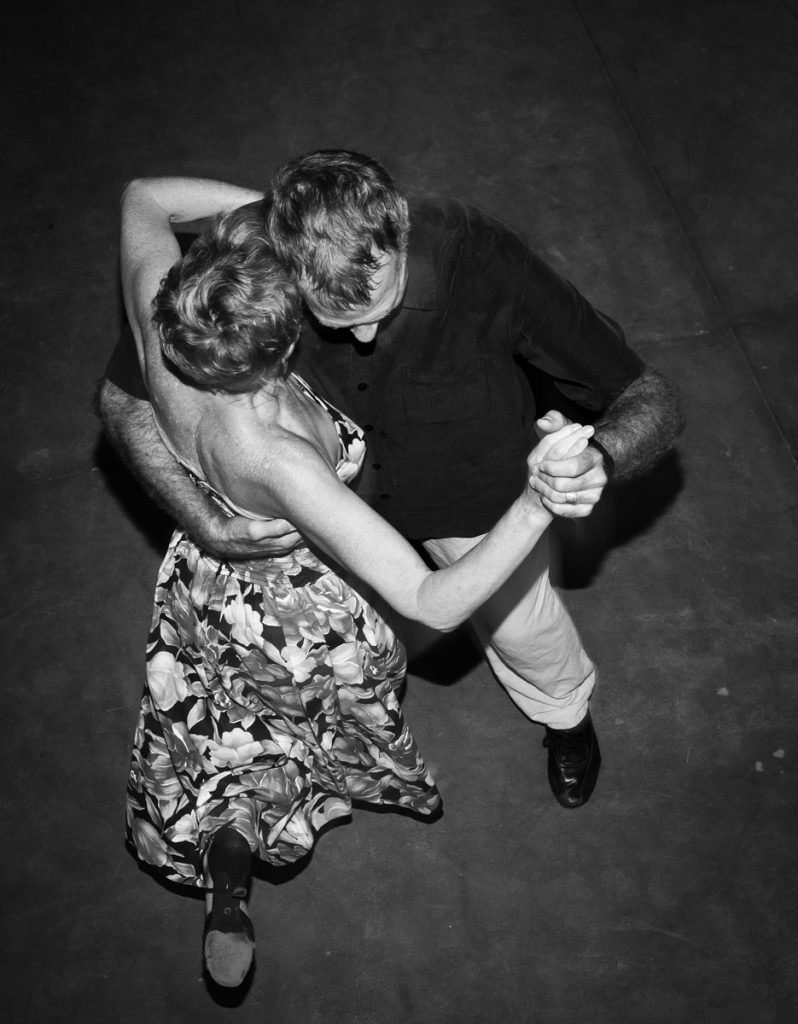
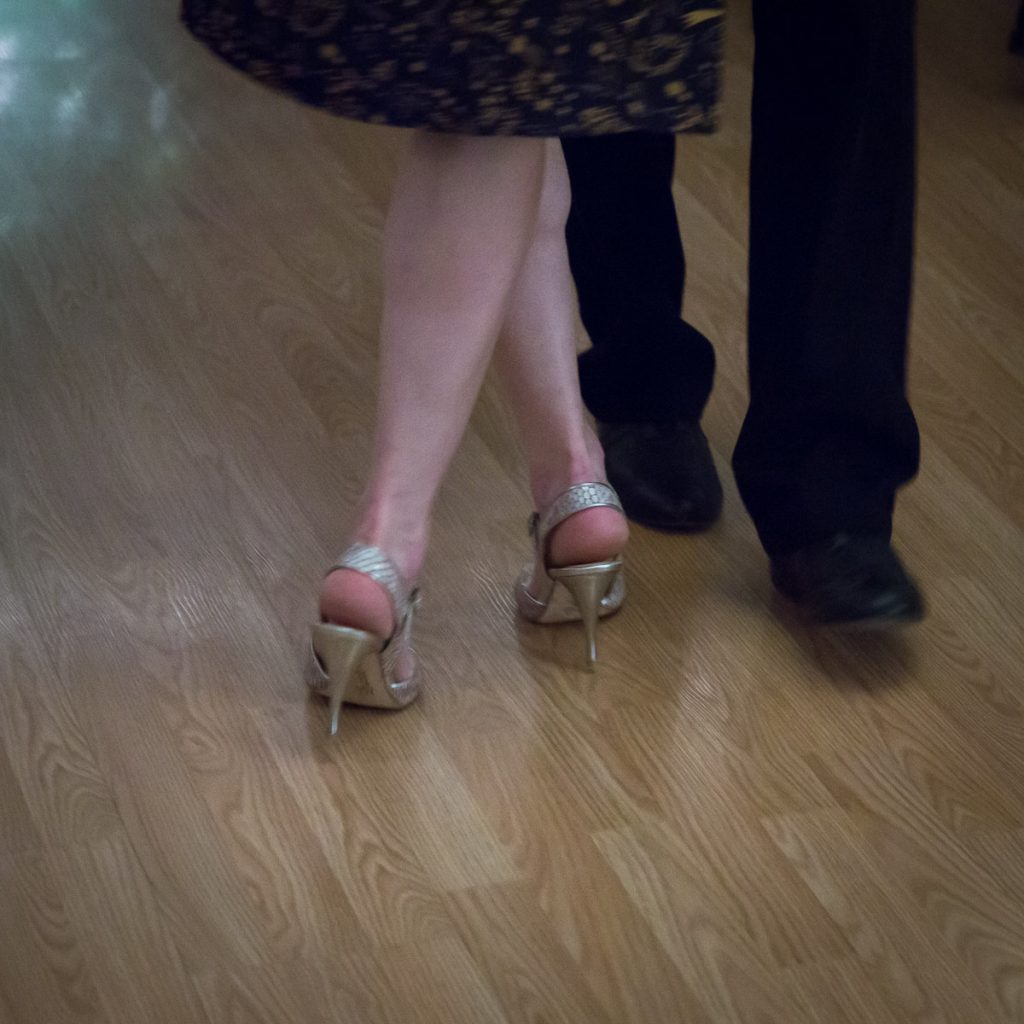
It takes two stories to tango...
{move to a page with a mindfulness/spiritual focus. remember insight as a bridge between spiritual and science.
We may grow old in the stories of our bodies, but we are not our bodies. We live through our bodies, separate and aware. Deep within, there is that witness, that awareness of our mental chatter. But we are not the chatter. We are the awareness, being. When we see there are two stories being written we understand that one is non-fiction and it’s about authoring life’s adventures in the other story, fictional in a way but real nonetheless. Our physical bodies wear the history of the second story, and is affected, for better or worse, by the life it leads. But we are not that other story.
Tango is the less traveled pathway to a captivating novel full of love and grief and joyful moments of connection and solitude. It is a bridge between our inner life and our physical self to experience life as dancer. Tango is the playground where our inner being embraces the dance, and our physical being embraces another.
Through movement and social connections within a safe environment, TangoMind trains you to open up to the authentic you, to show up and be. Being present with your authentic self is beneficial to all of life, and, like muscles, requires frequent practice. This intentional practice of Argentine Tango flows into all of life.
We cannot change out our bodies, but we can sculpt them from the inside out and give voice to our authenticity.
Life is the dancer, and you are the dance.”


